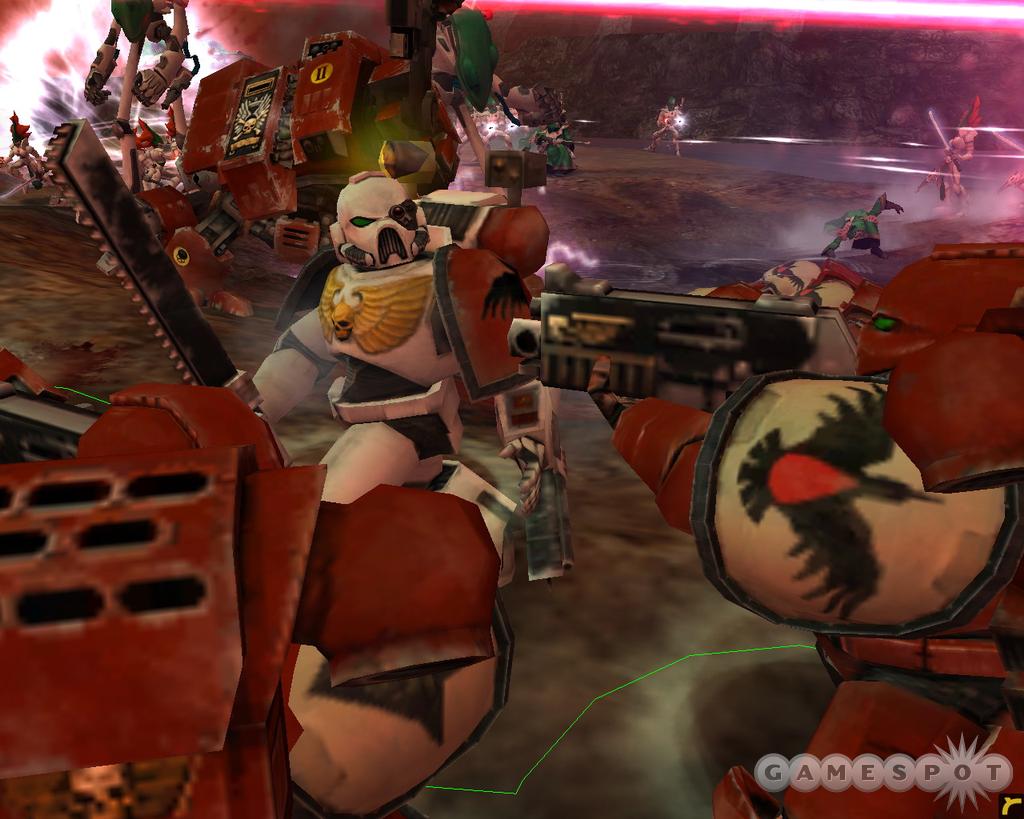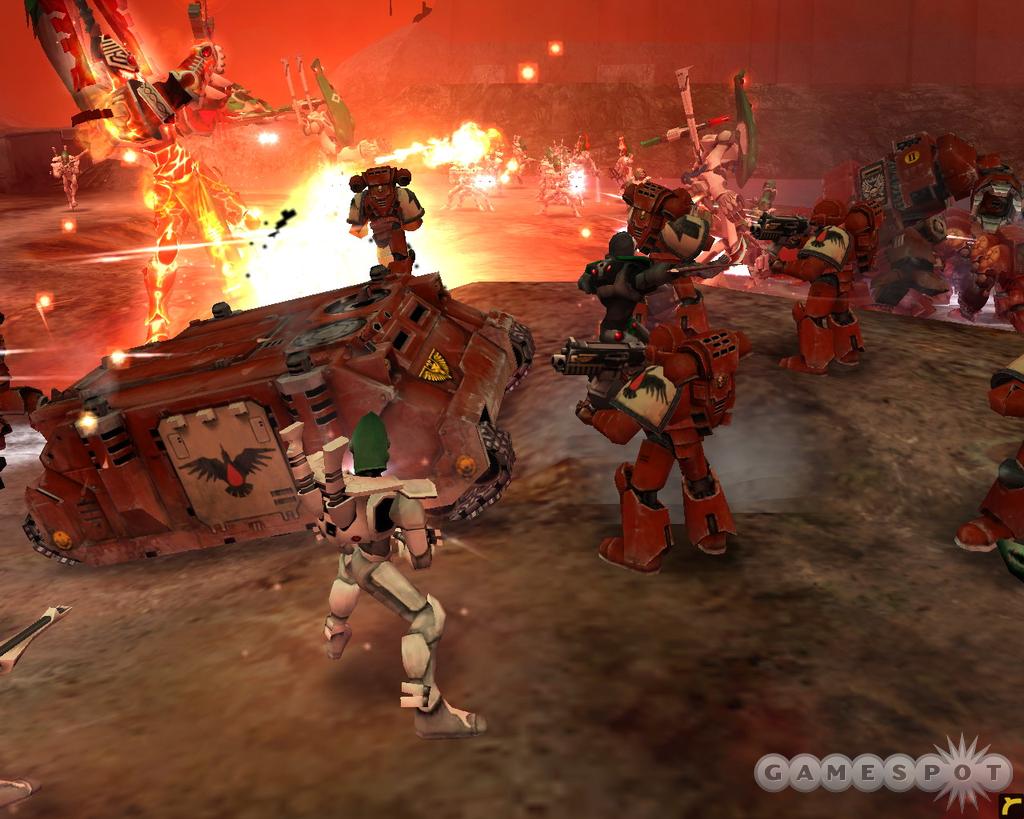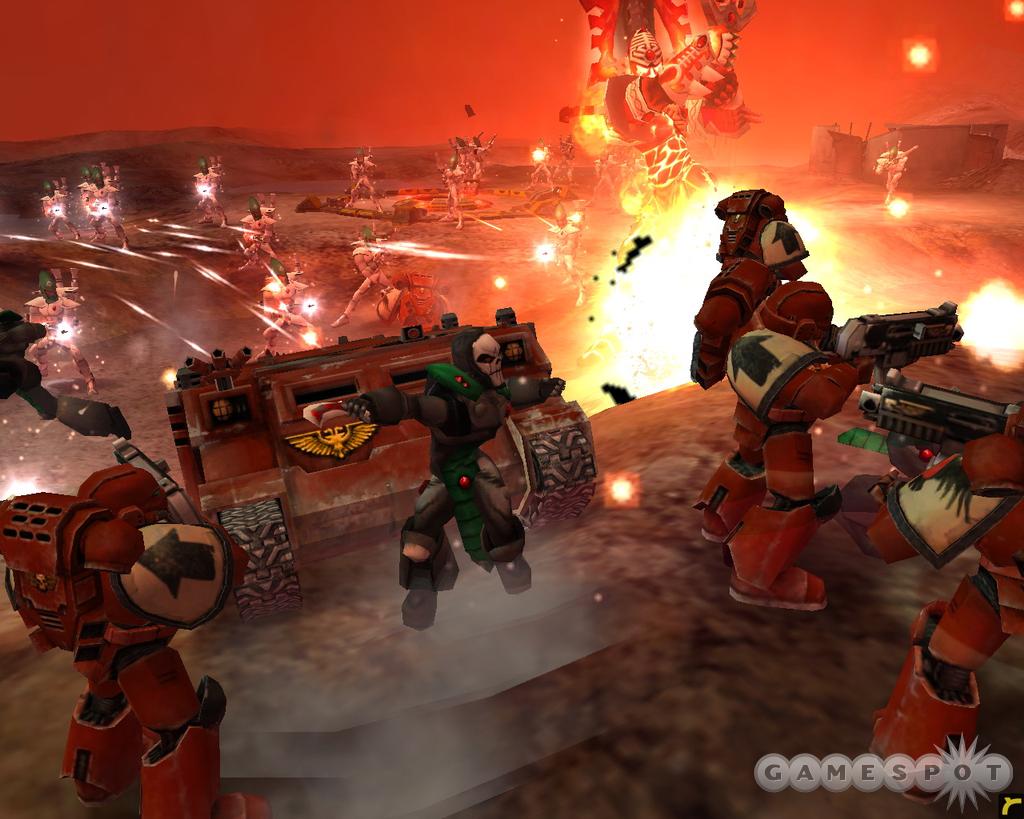Warhammer 40,000: Dawn of War Designer Diary #3
Three of Dawn of War's main designers discuss the difficulties and challenges involved in balancing the game's combat.
Warhammer 40,000: Dawn of War is a fast-paced, real-time strategy game based on the popular Warhammer 40,000 tabletop game. But don't expect a straight translation of the tabletop game, because developer Relic was given the green light to interpret the rules as it saw fit to make an exciting game. However, anytime a designer deals with something as large and complex as Warhammer 40,000, the challenge is to make a game that's fun and fair. In this edition of our designer diaries, three of the game's designers discuss the complex challenges that Warhammer presented.

Finding the Balance
By Jay Wilson, Andrew Chambers, and Mike EchinoLead Designer, Multiplayer Designer, and Lead Balance Tester, Relic
Jay Wilson
Multiplayer design and game balance are really the core of real-time strategy gameplay. You build your multiplayer game before you create a single mission or even start work on your artificial intelligence, and you base your gameplay around the concepts you establish during the initial design and play-testing of your multiplayer sessions. This diary is going to cover how we went from concept, to implementation, to final with the multiplayer aspects of Warhammer 40,000: Dawn of War.
One of the main advantages in the initial design phases of Dawn of War was that we could utilize the Warhammer 40,000 tabletop wargame as a jumping-off point for defining game intent and unit statistics. The downside to this is that the tabletop gaming system has many incompatibilities with a real-time strategy game, and we wanted to make sure that we didn't get hung up on trying to turn Dawn of War into something it could never be.
With this in mind, we established a few basic goals that would govern how we wanted the multiplayer game to play:
First, we wanted unit effectiveness and unit counters to be straightforward and easy for players to grasp. A lesson we learned through extensive balance iteration on Impossible Creatures is that just as important as having a solid system for establishing unit effectiveness is having that system be easily understood by players. Knowing that our other goals were focused on modifying this system was another reason to keep it very simple.
Luckily, this is an area where the tabletop game gave us a good set of examples to work from based on weapon effectiveness. Heavy bolters are effective against units with light armor, but they're not nearly as effective against units with power armor. Plasma guns are prized as weapons that are designed to take out units with high armor. And weapons like lascannons and missile launchers are valued for their ability to counter vehicles. Most weapons in the tabletop game fit into one of these three conventions: anti-infantry, anti-heavy infantry, or anti-vehicle. So we used this basic and easy-to-understand triangle as our foundation. Every weapon in the game would be focused on countering a specific unit type. We later added other unit types, like daemons, buildings, and commanders, which allowed us to diversify our counters a bit. However, the system remained relatively straightforward and easy to understand.
Second, effective tactics, like morale-killing units or gameplay elements (like cover), should allow players to alter or reverse counters. A primary goal of our game was that we wanted players to be able to use more than just typical real-time strategy unit counters to defeat their opponents. Two systems were primarily focused on this goal: morale and cover.
Cover, as a system, would allow players to utilize terrain to increase the survivability of their troops by placing them in specific locations on that terrain. This has obvious advantages, and it rewards players for smart use of various areas on the map. Early on, we were concerned about the power of infantry versus vehicles, so we made sure that this system benefited infantry far more than vehicles. Balance for cover was primarily a map-based issue, so once we got the system in the game, it pretty much stayed as is until we hit the final map design stage.

Morale, as a system, is designed to allow players to use specialized units, like snipers, or concentrated fire to overcome a superior foe. With units collected together in squads (and subsequently sustaining morale damage at a squad level), it is possible for a player to counter the effectiveness of a squad by breaking it and therefore making it combat ineffective. With this system, players would have an alternative to wiping an enemy out--an alternative that is much simpler to accomplish. Morale acts as a good foil for cover as well, since cover provides little benefit from morale damage.
Our third goal was that close combat versus ranged combat should be a major component of unit balance. Close-combat units should be able to negate the effectiveness of ranged units by engaging them. One of the main tactical concepts of the Warhammer 40,000 tabletop game is the use of close combat versus ranged combat. Close-combat units in the tabletop game are quite powerful, because they not only deal a lot of damage but also they can stop ranged-focused units from firing their weapons, consequently forcing them to fight in a manner that does not suit them. This concept does not really exist in real-time strategy, because--generally--the only way to stop a unit from doing what it is good at is to kill it.
We knew this was definitely a concept we wanted to transfer over to the real-time strategy game, so we determined that all infantry needed to have close-combat attacks. If infantry units were engaged in close combat, than they would prevent most ranged units from being able to shoot. However, we also put in several simple systems to change the dynamic of ranged units so that some could fire on the move while others were most effective when stationary. Again, these were all concepts from the tabletop game that we pulled into Dawn of War to increase the level of its tactical gameplay.
Time to Kill
The fourth goal was that vehicles should be more realistic than most RTS games portray them. That is, they should be less vulnerable to small-arms fire. There is a very good reason most RTS games don't have realistic vehicles. Such extreme counters can be devastating in-game, and they can be frustrating to players. Additionally, vehicles tend to imbalance a game toward such überunits. However, it's our firm belief that holding on to such unrealistic concepts as machine guns gunning down tanks is one of the things that is starting to make RTS games unenjoyable for a lot of players. 
At Relic, we rarely make high-level decisions like this based on potential balance problems, because being ruled by this can force you to make unimaginative choices. So, instead, we looked at high-level ways to address the problems we knew would arise from having really strong vehicles in the game. Cost, build time, and tech-tree placement are obviously big factors in balancing out extreme counters, but this would not be enough. Realistic vehicles should only be able to be deployed in realistic numbers, so we decided early on that we'd need an independent cap on the number of vehicles the player could choose to keep so that the total number of vehicles was kept under control. This would also prevent the player from having to choose between vehicles or infantry in ways that might go beyond the simple expenditure of resources.
We also built into our system lots of advantages for infantry to counter the power of vehicles. There are things like cover benefits, infantries' abilities to capture resources, vehicle reliance on secondary (harder to acquire) resources, and the fact that most special abilities benefit infantry and not vehicles.
And our fifth goal was that each race should have a unique play style. This is simple to say but harder to achieve. We've discussed how each race is different in other forums, so I won't get into those details here. But suffice it to say we established this as an early goal for our multiplayer game.
With these goals in place, we went about building a basic, playable version of the game. We'd already tested major systems, like cover, morale, our resource system, and combat times, in the prototype, so this build focused on getting all the tech trees and units in--but not more-advanced functions, like abilities, which came in piecemeal throughout the remainder of production. With all the elements in place and functioning, it was time to move from theory to practice to begin balancing the game.
Andrew Chambers
With the intent of the multiplayer game established, it was up to me to take that intent and figure out how we were going to make it a reality. We had a destination. Now we just needed a road. I was tasked with laying that road.
Let me give you some basic numbers on the scale of the task at hand. Dawn of War consists of four races, each with at least 14 different unit types. Most units can be equipped with a variety of weapons. Even the most basic unit, a space marine squad, can be a mix of five different weapons. We have 14 different armor classes, all of which take different amounts of damage from every weapon in the game. All of this makes for an approximate total of 400,000 different possible combinations of weapon versus armor, all of which need to be balanced!

My first course of action was to talk to the other designers at Relic who had balanced our previous games. Damon Gauthier was largely responsible for balancing Homeworld 2, which, by all accounts, turned out really well. We sat down together and talked about the process he used to balance the two races of Homeworld 2. We spoke about the new system, which he called "Balance for Time."
Fun has always been the focus of Dawn of War. We wanted the balance to accommodate that, and in an RTS game, a large part of what makes it fun is the pacing of the combat. Games like Impossible Creatures have a very fast combat pace, whereas games like Homeworld 2 have quite a slow combat pace. It gives a very different feel to the game. We wanted Dawn of War to be slightly on the fast side to give a sense of hectic action, but we wanted it to be slower than, say, Impossible Creatures. In order to achieve this, we decided not to balance for effectiveness but instead decided to balance for time.
We developed "Time to Kill" for all the different unit relationships in the game. These were our baselines that represented the minimum time it would take for X to kill Y, with all other factors being equal. The balance team took these times and modified weapon damages until they were at a point where I felt comfortable with them.
The Perception of Fair
With this baseline time established, we then went ahead and determined effectiveness values for all of the unit weapon types versus armor types. This was basically an immense Excel spreadsheet that had every unit with every weapon combination in the game versus every armor type in the game. There was also a number from one to 10 defining how good that weapon would be at killing that armor type. It was huge, and it took awhile to put together. You can imagine my dismay when, at one point, I deleted the entire thing, losing a good 10 hours of work. However, the data was invaluable. Dawn of War is, of course, based on the very popular Warhammer 40,000 universe. In this universe, certain weapons and units are established as being effective against certain things. It was my job to ensure that these relationships stayed true and carried over to the balance of Dawn of War. 
Mike Echino
Our next hurdle to overcome was to hire a professional play-test team. Professional play testers are guys who live and breathe real-time strategy games. These guys love playing real-time strategy games, and for them, it's a dream to work for a game developer. So we had no problem recruiting a stable of "pro gamers" to balance Warhammer.
Now that the test team and the "Time to Kill" system were firmly in place, we were ready to get to work! First, we broke the game down into a number of components. We decided that the first step was to get the game playable. In order to do that, we had to balance the base units. We achieved this using the aforementioned tools, "Time to Kill," and the unit effectiveness charts. We gave the units and weapons effectiveness values to determine their costs. Once the costs were in place, we plugged the numbers into the battle simulator. The battle simulator allowed us to run hundreds of battles simultaneously. We then used the results to tweak and hone our original statistics.
We decided, as a team, that we did not have enough time to individually master all the playable races in Warhammer, so we assigned a race to each of the play testers. The play testers were then responsible for finding any glaring imbalances that pertained to his race. By thoroughly understanding each race, we were more accurately able to verify and solve problems. With the basic structure in place, the balance team began playing Dawn of War competitively. Daily statistics were taken and collected on the success rates of both the players and the races. This helped us to determine which races were too strong or too weak.
Even though the play balancers did an amazing job in so little time, we knew that having a public beta would be very beneficial. We wanted to make sure that the game would be fun for everyone, not just for the developers and play testers. The feedback we garnered from the public beta test was invaluable, and it helped us to create a game experience that appeals to casual players and hardcore players alike.
Jay Wilson
The hardest thing about balancing a real-time strategy game is perception. You can numerically assure that one unit is not greater than another or that one race cannot reach unit X before another race can effectively counter that unit, but what you can't control is what players will perceive is or is not balanced, based on their play experience and style.
Take the 400,000 possible combinations of weapons and units, and multiply it by the thousands and thousands of players who will interpret these options in different ways, and you are faced with a task so terrifying that most developers would be wise to simply avoid the whole thing altogether! But where's the fun in that?!
This is why our primary goal has always been to make the game fun, first and foremost. It's true that unbalanced games are not fun, but overly balanced games aren't fun either. One of the things that has made the Warhammer tabletop game such an enduring pastime is that every race gets extreme tactics and powers, which is something so great that it seems like it could never be balanced, even though it seems like, for the most part, win ratios are fairly even between the different races. Debating, using, and getting abused by these tactics is part of the fun, and we were determined to bring that into Dawn of War.
In the end, strategy games are all about taking it to the other guy, and as long as we're working on Dawn of War, we'll make sure you can do just that--in a fun and fair way.
Got a news tip or want to contact us directly? Email news@gamespot.com
Join the conversation